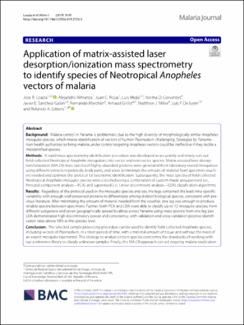| dc.contributor.author | Loaiza, Jose R. | |
| dc.contributor.author | Almanza, Alejandro | |
| dc.contributor.author | Rojas, Juan C. | |
| dc.contributor.author | Mejía, Luis | |
| dc.contributor.author | Cervantes, Norma D. | |
| dc.contributor.author | Sanchez‑Galan, Javier E. | |
| dc.contributor.author | Merchán, Fernando | |
| dc.contributor.author | Grillet, Arnaud | |
| dc.contributor.author | Miller, Matthew J. | |
| dc.contributor.author | De León, Luis F. | |
| dc.contributor.author | Gittens, Rolando A. | |
| dc.date.accessioned | 2020-06-30T04:46:22Z | |
| dc.date.available | 2020-06-30T04:46:22Z | |
| dc.date.issued | 2019-03-22 | |
| dc.identifier.other | https://doi.org/10.1186/s12936-019-2723-0 | |
| dc.identifier.uri | http://repositorio-indicasat.org.pa/handle/123456789/141 | |
| dc.description | Background: Malaria control in Panama is problematic due to the high diversity of morphologically similar Anopheles mosquito species, which makes identifcation of vectors of human Plasmodium challenging. Strategies by Panama‑ nian health authorities to bring malaria under control targeting Anopheles vectors could be inefective if they tackle a misidentifed species.
Methods: A rapid mass spectrometry identifcation procedure was developed to accurately and timely sort out feld-collected Neotropical Anopheles mosquitoes into vector and non-vector species. Matrix-assisted laser desorp‑ tion/ionization (MALDI) mass spectra of highly-abundant proteins were generated from laboratory-reared mosquitoes using diferent extraction protocols, body parts, and sexes to minimize the amount of material from specimen vouch‑ ers needed and optimize the protocol for taxonomic identifcation. Subsequently, the mass spectra of feld-collected Neotropical Anopheles mosquito species were classifed using a combination of custom-made unsupervised (i.e., Principal component analysis—PCA) and supervised (i.e., Linear discriminant analysis—LDA) classifcation algorithms. Results: Regardless of the protocol used or the mosquito species and sex, the legs contained the least intra-specifc variability with enough well-preserved proteins to diferentiate among distinct biological species, consistent with pre‑ vious literature. After minimizing the amount of material needed from the voucher, one leg was enough to produce reliable spectra between specimens. Further, both PCA and LDA were able to classify up to 12 mosquito species, from diferent subgenera and seven geographically spread localities across Panama using mass spectra from one leg pair. LDA demonstrated high discriminatory power and consistency, with validation and cross-validation positive identif‑ cation rates above 93% at the species level.
Conclusion: The selected sample processing procedure can be used to identify feld-collected Anopheles species, including vectors of Plasmodium, in a short period of time, with a minimal amount of tissue and without the need of an expert mosquito taxonomist. This strategy to analyse protein spectra overcomes the drawbacks of working with‑ out a reference library to classify unknown samples. Finally, this MALDI approach can aid ongoing malaria eradication | en_US |
| dc.description.abstract | Background: Malaria control in Panama is problematic due to the high diversity of morphologically similar Anopheles mosquito species, which makes identifcation of vectors of human Plasmodium challenging. Strategies by Panama‑ nian health authorities to bring malaria under control targeting Anopheles vectors could be inefective if they tackle a misidentifed species.
Methods: A rapid mass spectrometry identifcation procedure was developed to accurately and timely sort out feld-collected Neotropical Anopheles mosquitoes into vector and non-vector species. Matrix-assisted laser desorp‑ tion/ionization (MALDI) mass spectra of highly-abundant proteins were generated from laboratory-reared mosquitoes using diferent extraction protocols, body parts, and sexes to minimize the amount of material from specimen vouch‑ ers needed and optimize the protocol for taxonomic identifcation. Subsequently, the mass spectra of feld-collected Neotropical Anopheles mosquito species were classifed using a combination of custom-made unsupervised (i.e., Principal component analysis—PCA) and supervised (i.e., Linear discriminant analysis—LDA) classifcation algorithms. Results: Regardless of the protocol used or the mosquito species and sex, the legs contained the least intra-specifc variability with enough well-preserved proteins to diferentiate among distinct biological species, consistent with pre‑ vious literature. After minimizing the amount of material needed from the voucher, one leg was enough to produce reliable spectra between specimens. Further, both PCA and LDA were able to classify up to 12 mosquito species, from diferent subgenera and seven geographically spread localities across Panama using mass spectra from one leg pair. LDA demonstrated high discriminatory power and consistency, with validation and cross-validation positive identif‑ cation rates above 93% at the species level.
Conclusion: The selected sample processing procedure can be used to identify feld-collected Anopheles species, including vectors of Plasmodium, in a short period of time, with a minimal amount of tissue and without the need of an expert mosquito taxonomist. This strategy to analyse protein spectra overcomes the drawbacks of working with‑ out a reference library to classify unknown samples. Finally, this MALDI approach can aid ongoing malaria eradication | en_US |
| dc.language.iso | eng | en_US |
| dc.rights | info:eu-repo/semantics/openAccess | |
| dc.rights | http://creativecommons.org/licenses/by/4.0/ | |
| dc.subject | Anopheles mosquito | en_US |
| dc.subject | Taxonomic identification | en_US |
| dc.subject | MALDI | en_US |
| dc.subject | Mass spectrometry | en_US |
| dc.subject | Malaria vector | en_US |
| dc.subject | Panama | en_US |
| dc.title | Application of matrix-assisted laser desorption/ionization mass spectrometry to identify species of Neotropical Anopheles vectors of malaria | en_US |
| dc.type | info:eu-repo/semantics/article | en_US |
| dc.type | info:eu-repo/semantics/publishedVersion | |

